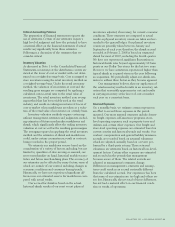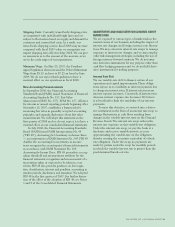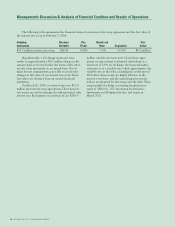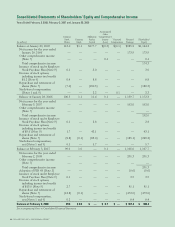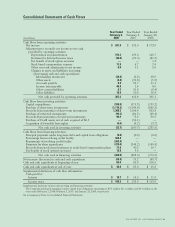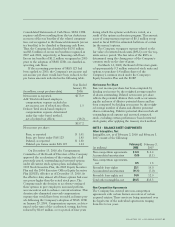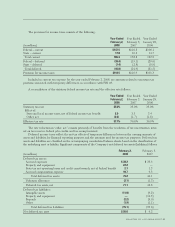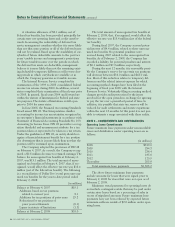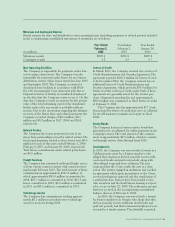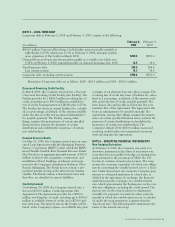Dollar Tree 2007 Annual Report Download - page 35
Download and view the complete annual report
Please find page 35 of the 2007 Dollar Tree annual report below. You can navigate through the pages in the report by either clicking on the pages listed below, or by using the keyword search tool below to find specific information within the annual report.
DOLLAR TREE, INC. • 2007 ANNUAL REPORT
33
municipal bonds can be converted into cash depend-
ing on terms of the underlying agreement. Short-term
investments at February 3, 2007 also included auction
rate securities. The auction rate securities have stated
interest rates, which typically reset to prevailing
market rates every 35 days or less. The securities
underlying both the government-sponsored municipal
bonds and the auction rate securities have longer legal
maturity dates.
Merchandise Inventories
Merchandise inventories at the distribution centers are
stated at the lower of cost or market, determined on a
weighted average cost basis. Cost is assigned to store
inventories using the retail inventory method, deter-
mined on a weighted average cost basis.
Costs directly associated with warehousing and
distribution are capitalized as merchandise inventories.
Total warehousing and distribution costs capitalized
into inventory amounted to $26.3 million and $25.6
million at February 2, 2008 and February 3, 2007,
respectively.
Property, Plant and Equipment
Property, plant and equipment are stated at cost and
depreciated using the straight-line method over the
estimated useful lives of the respective assets as follows:
Buildings 39 to 40 years
Furniture, fixtures and equipment 3 to 15 years
Transportation vehicles 4 to 6 years
Leasehold improvements and assets held under
capital leases are amortized over the estimated useful
lives of the respective assets or the committed terms
of the related leases, whichever is shorter.
Amortization is included in “selling, general and
administrative expenses” on the accompanying consoli-
dated statements of operations.
Costs incurred related to software developed for
internal use are capitalized and amortized over three
years. Costs capitalized include those incurred in the
application development stage as defined in Statement
of Position 98-1, Accounting for the Costs of Computer
Software Developed or Obtained for Internal Use.
Goodwill and Other Intangible Assets
Goodwill and other intangible assets with indefinite
useful lives are not amortized, but rather tested for
impairment at least annually. In accordance with SFAS
No. 142, goodwill is no longer being amortized, but is
tested annually for impairment. In addition, goodwill
will be tested on an interim basis if an event or cir-
cumstance indicates that it is more likely than not that
an impairment loss has been incurred. The Company
performed its annual impairment testing in November
2007 and determined that no impairment loss existed.
Intangible assets with finite useful lives are amortized
over their respective estimated useful lives and
reviewed for impairment in accordance with SFAS
No. 144. The Company performs its annual assessment
of impairment following the finalization of each
November’s financial statements.
Impairment of Long-Lived Assets and Long-Lived Assets
to Be Disposed Of
The Company reviews its long-lived assets and certain
identifiable intangible assets for impairment whenever
events or changes in circumstances indicate that the
carrying amount of an asset may not be recoverable, in
accordance with Statement of Financial Accounting
Standards (SFAS) No. 144, Accounting for the
Impairment or Disposal of Long-Lived Assets.
Recoverability of assets to be held and used is meas-
ured by comparing the carrying amount of an asset to
future net undiscounted cash flows expected to be
generated by the asset. If such assets are considered to
be impaired, the impairment to be recognized is meas-
ured as the amount by which the carrying amount of
the assets exceeds the fair value of the assets based on
discounted cash flows or other readily available evi-
dence of fair value, if any. Assets to be disposed of are
reported at the lower of the carrying amount or fair
value less costs to sell. In fiscal 2007, 2006 and 2005,
the Company recorded charges of $0.8 million, $0.5
million and $0.2 million, respectively, to write down
certain assets. These charges are recorded as a compo-
nent of “selling, general and administrative expenses” in
the accompanying consolidated statements of operations.
Financial Instruments
The Company utilizes derivative financial instruments
to reduce its exposure to market risks from changes in
interest rates. By entering into receive-variable, pay-
fixed interest rate swaps, the Company limits its expo-
sure to changes in variable interest rates. The
Company is exposed to credit-related losses in the
event of non-performance by the counterparty to the
interest rate swaps; however, the counterparties are
major financial institutions, and the risk of loss due to
non-performance is considered remote. Interest rate
differentials paid or received on the swaps are recog-
nized as adjustments to expense in the period earned
or incurred. The Company formally documents all
hedging relationships, if applicable, and assesses hedge
effectiveness both at inception and on an ongoing
basis. The Company’s remaining interest rate swap
does not qualify for hedge accounting treatment pur-
suant to the provisions of SFAS No. 133, Accounting
for Derivative Instruments and Hedging Activities (SFAS


